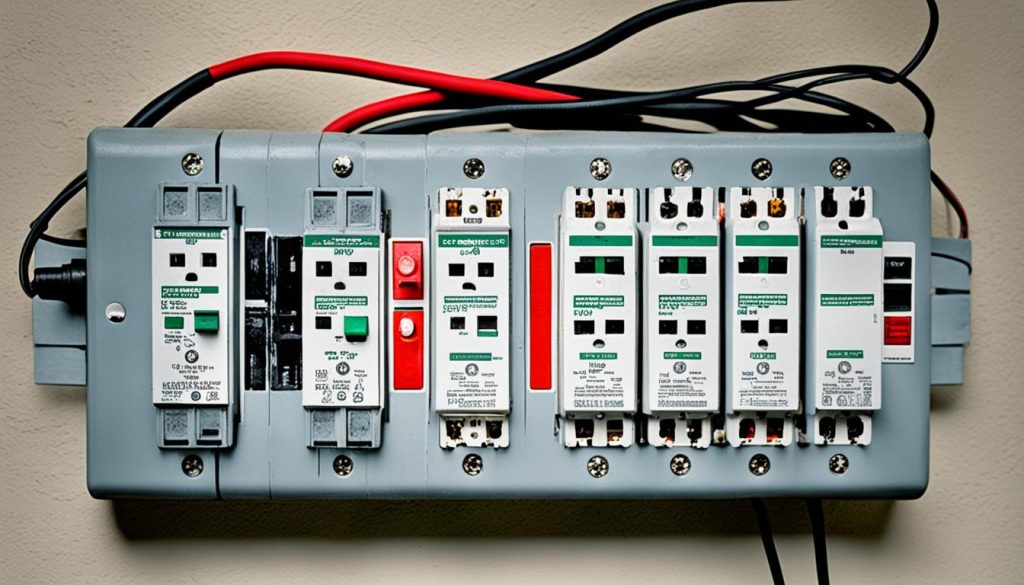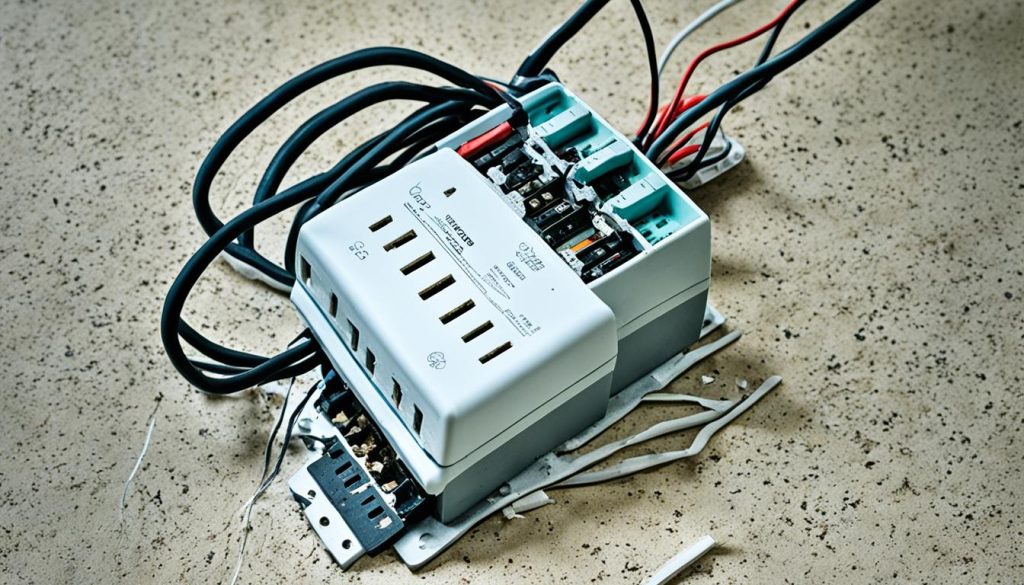Surge protectors are essential devices that protect your electronic equipment from power surges. However, you may be wondering, do surge protectors wear out? The answer is yes, surge protectors have a limited lifespan and can wear out over time. It’s crucial to understand the signs of surge protector failure and the importance of replacing them when necessary.
Key Takeaways:
- Surge protectors have a lifespan of about three to five years and should be replaced regularly.
- Signs of surge protector failure include an unlit LED diagnostic light.
- Surge protectors are different from power strips and provide varying levels of protection.
- Inspect your surge protector regularly to ensure its effectiveness in protecting your electronics.
- Investing in new surge protectors is essential to safeguard your electronics from power surges.
Understanding Surge Protectors vs. Power Strips
Power strips and surge protectors are often confused, but they are not the same. Power strips are simple, inexpensive devices that provide additional outlets but offer little to no protection from electrical issues.
On the other hand, surge protectors, also known as surge suppressors, provide varying levels of protection from power surges. Surge protectors are more elaborate and can handle power spikes before your electronic devices are at risk.
When it comes to protecting your valuable electronics, it’s important to choose a surge protector over a simple power strip. Surge protectors are designed to safeguard your devices from power surges, which can occur due to lightning strikes, faulty wiring, or other electrical disturbances.
“A power strip provides more outlets, but it won’t protect your devices from power surges. A surge protector, on the other hand, offers the added benefit of preventing damage to your electronics.”
– John Adams, Electrical Engineer
Surge protectors come in different types and models, each offering a specific level of protection measured in joules. The joule rating indicates how much energy the surge protector can handle before it becomes ineffective. When selecting a surge protector, it’s essential to consider the power needs of your devices and choose one with a sufficient joule rating.
Remember, using a power strip when you need surge protection is like relying on an umbrella during a hurricane. It simply won’t provide the necessary defense for your precious electronics.
Surge Protectors vs. Power Strips Comparison
| Feature | Power Strip | Surge Protector |
|---|---|---|
| Provides additional outlets | ✓ | ✓ |
| Protects devices from power surges | ❌ | ✓ |
| Handles power spikes | ❌ | ✓ |
| Joule rating | N/A | Varies (choose according to device needs) |
Determining Surge Protector Lifespan
Surge protectors are an essential component in safeguarding your electronic devices from damaging power surges. Understanding the lifespan of surge protectors is crucial for maintaining their effectiveness and protecting your valuable electronics.
Surge protectors are rated based on their ability to handle electrical energy, measured in joules. The higher the joule rating, the better the protection provided. This rating indicates the maximum amount of energy a surge protector can absorb before it becomes overloaded.
Over time, the internal components of a surge protector can wear down, reducing its ability to handle power surges effectively. Unfortunately, there is no definitive way to determine exactly how much protection a surge protector has left or if its initial joule rating is still accurate.
One way to ensure you are purchasing a reliable surge protector is to buy from reputable companies that offer warranties. A warranty provides an added guarantee of quality and can give you peace of mind knowing that the manufacturer stands behind their product.
Some surge protectors even provide a warranty on the connected equipment, which offers additional protection. If any of your devices connected to the surge protector are damaged due to a power surge, the manufacturer will cover the cost of repair or replacement as specified in the warranty.
When shopping for a surge protector, look for one with a high joule rating and a warranty that suits your needs. This combination will provide you with the best possible protection for your electronics.

| Factors to Consider for Surge Protector Lifespan | Impact on Lifespan |
|---|---|
| Manufacturer | Different manufacturers may use varying quality components, affecting the lifespan of the surge protector. |
| Usage | Frequent power surges or voltage fluctuations can shorten the lifespan of a surge protector. |
| Environment | High temperatures or excessive humidity can accelerate the wear and tear on a surge protector. |
| Power Grid | The stability and quality of your local power grid can impact the lifespan of the surge protector. |
Signs of Surge Protector Failure
Some surge protectors come with built-in warning lights or end of life indicators that visually signal when the device needs to be replaced. These indicators can be in the form of a continuous illumination for a functional surge protector and an unlit light for a device in need of replacement. Advanced surge protectors may also have audible alarms or remote monitoring capabilities to alert you of device failure. Regular inspections are necessary to ensure your surge protector is still providing the necessary protection for your electronics.

Importance of Replacing Surge Protectors
When it comes to protecting your valuable electronic devices, surge protectors play a crucial role. However, it’s important to understand that surge protectors do not last forever. Over time, they wear out and become less effective in safeguarding your electronics against power surges. That’s why it’s essential to replace surge protectors once they reach the end of their lifespan.
Continuously using an outdated surge protector puts your electronics at risk of damage from power surges. As surge protectors age, their ability to handle electrical energy diminishes, making them unable to provide adequate protection. By investing in new surge protectors every three to five years, you can ensure maximum protection for your electronic devices.
Replacing surge protectors is not only crucial for the safety of your electronics but also a cost-effective measure. By staying proactive in replacing surge protectors, you can prevent potential damage from power surges and save yourself from expensive repairs or replacements of your electronic devices.
Remember, choosing surge protectors from reputable brands and manufacturers is essential. Look for surge protectors with high joule ratings and warranties to ensure you are getting a reliable and long-lasting product. So don’t put your electronics at risk—replace surge protectors regularly to safeguard your valuable devices and enjoy peace of mind.
FAQ
Do surge protectors wear out over time?
Yes, surge protectors have a limited lifespan and can wear out. Experts recommend replacing surge protectors every three to five years to ensure maximum protection.
How can I tell if my surge protector is failing?
Signs of surge protector failure include a lit LED diagnostic light, indicating the device is still functioning, and an unlit light, which indicates the need for replacement. Regular inspections are essential to ensure your surge protector is still providing adequate protection.
What is the difference between a surge protector and a power strip?
Power strips are simple devices that offer additional outlets but provide little to no protection from electrical issues. In contrast, surge protectors, also known as surge suppressors, offer varying levels of protection from power surges and are essential for safeguarding your electronics.
How long does a surge protector last?
The lifespan of a surge protector can vary, but most need to be replaced every three to five years. It’s important to choose surge protectors from reputable companies that offer warranties.
What are some signs of surge protector failure?
Some surge protectors have built-in warning lights or end-of-life indicators that visually signal when replacement is necessary. These indicators can be in the form of continuous illumination for a functional surge protector or an unlit light for a device in need of replacement. Advanced surge protectors may also have audible alarms or remote monitoring capabilities to alert you of device failure.
Why is it important to replace surge protectors?
Surge protectors wear out over time, and their effectiveness decreases. Continuously using an outdated surge protector puts your electronics at risk of damage from power surges. Replacing surge protectors every three to five years is a cost-effective measure to ensure the safety of your electronics.


